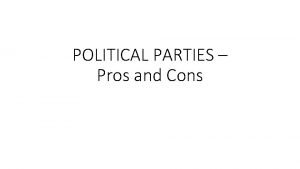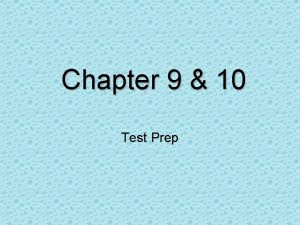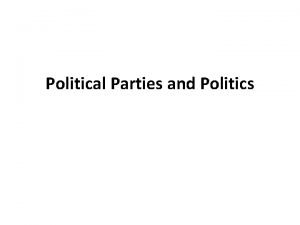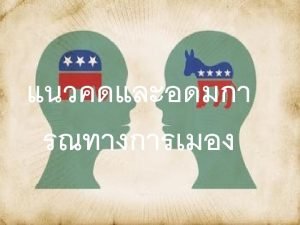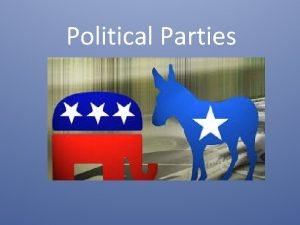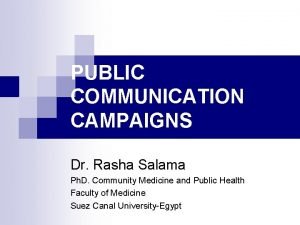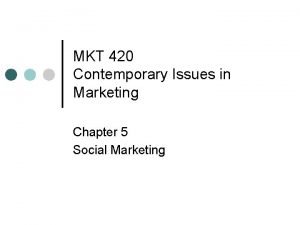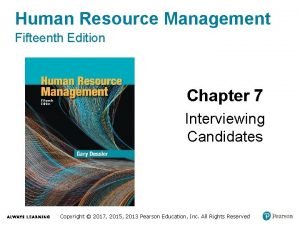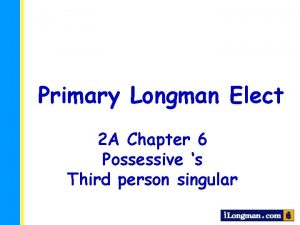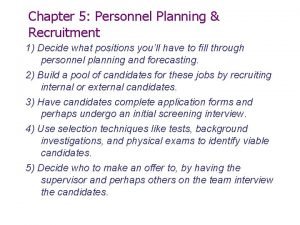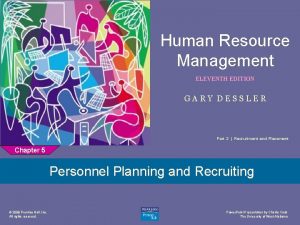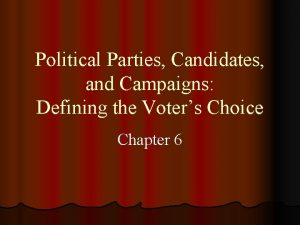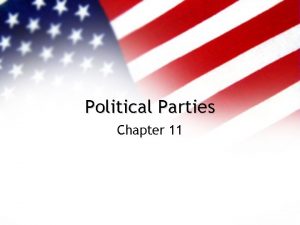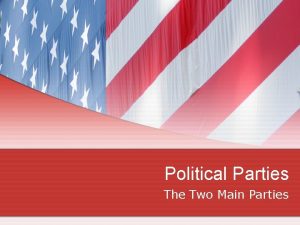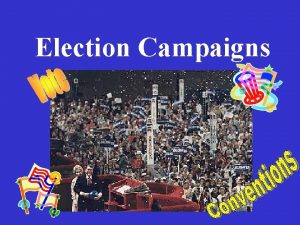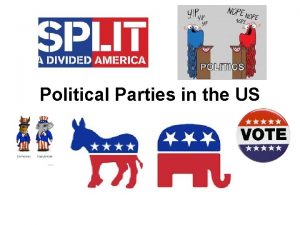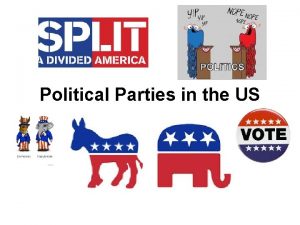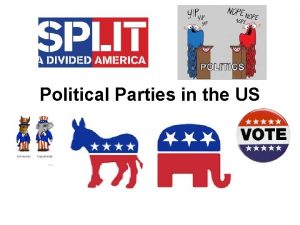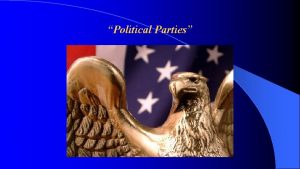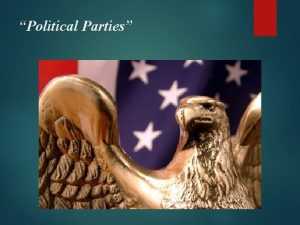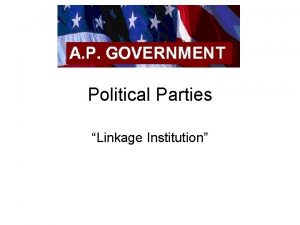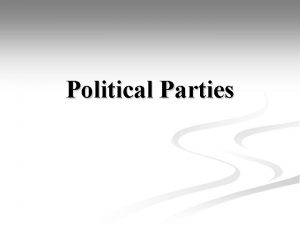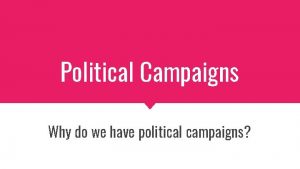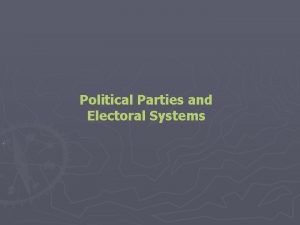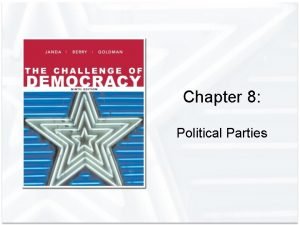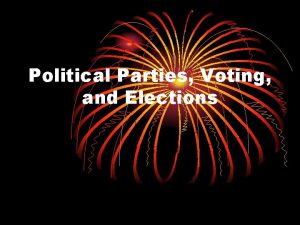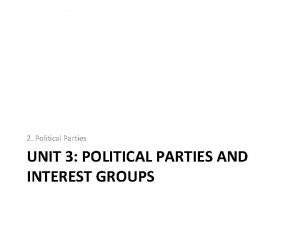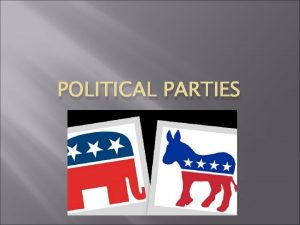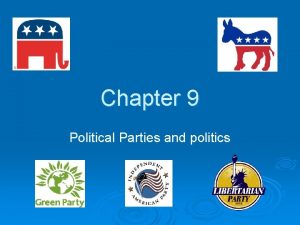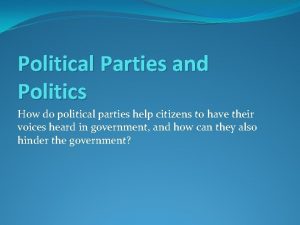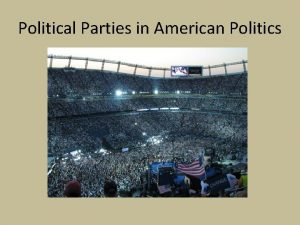8 Political Parties Candidates and Campaigns Defining the
































- Slides: 32

8: Political Parties, Candidates, and Campaigns Defining the Voter’s Choice ©Mc. Graw-Hill Education. All rights reserved. Authorized only for instructor use in the classroom. No reproduction or further distribution permitted without the prior written consent of Mc. Graw-Hill Education.

Party Competition and Majority Rule • Political party: an ongoing coalition of interests joined together in an effort to get its candidates for public office elected under a common label • Campaigns are both party and candidate centered – Parties compete, but individual candidates devise strategies, choose issues, and form campaign organizations • Parties are linkage institutions serving to connect citizens with government • Party competition narrows voters’ options to two, enabling diverse interests to more easily act together ©Mc. Graw-Hill Education.

The First Parties • America’s first parties originated in the rivalry between Alexander Hamilton and Thomas Jefferson – Hamilton’s Federalist Party • Focused on strengthening the federal government through national commerce • Election defeat in 1800 ended the Federalist control – Jefferson’s Democratic-Republican Party • Focused on small farmers and states’ rights advocates • Policy differences split the party under Monroe – Became the party we know today as the Democrats ©Mc. Graw-Hill Education.

Andrew Jackson and Grassroots Parties • Democrats reorganized into a grassroots party – Grassroots party: party organized at the local level – Open to more citizen participation – Contributed to a four-fold increase in election turnout • New opposition emerged – Short-lived Whig Party • Northern-based Republicans – Won the presidential election of 1860 – Lincoln’s election prompted the southern states to secede from the Union ©Mc. Graw-Hill Education.

Figure 8 -1 A Graphic History of America’s Major Parties The U. S. party system has been remarkable for its continuity. Competition between two major parties has been a persistent feature of the system. ©Mc. Graw-Hill Education.

Republicans versus Democrats: Realignments and the Enduring Party System • Two-party system has endured since the Civil War • Party realignments, periods of extraordinary change, have typically involved three basic elements: – Divisive issues that disrupt the existing political order – Election in which voters shift their partisan support – Enduring change in the parties’ policies and coalitions • Realignments are rare – Civil War—Republicans gain control – 1896—Republicans solidify control – 1932—Democrats gain control ©Mc. Graw-Hill Education.

Figure 8 -2 The Making of a Democratic Majority Based on voting in 1932, 1936, and 1940, first-time eligible voters during the Great Depression strongly backed the Democratic Party, positioning it to dominate national politics for the next three decades. ©Mc. Graw-Hill Education. Source: Kristi Andersen, The Creation of a Democratic Majority, 1928– 1936 (Chicago: University of Chicago Press, 1979), 63.

The Nature and Origins of Today’s Party Alignment • End of the New Deal Democratic coalition • Control of the South shifted to the Republicans – State governments and House seats have also gone mostly to Republicans – Democrats offset southern losses with gains in the North – Current realignment has been slow – Republicans have gained the most • Parties are now closely matched in party loyalties • Analysts speculate that a new realignment could be taking shape ©Mc. Graw-Hill Education.

Figure 8 -3 Percentage of U. S. House Seats Held by Democrats in the South and New England In elections to the U. S. House of Representatives in recent decades, the southern states have increasingly voted Republican while the New England states have increasingly voted Democratic. ©Mc. Graw-Hill Education.

Parties and the Vote • Party identification is key – Rare for a party nominee to get less than 80 percent of the partisan vote • Voters who cast a straight ticket uniformly support their party’s candidates • Far less common is split-ticket voting, supporting candidates from both parties – Only about 20 percent of voters split their ticket ©Mc. Graw-Hill Education.

Voting a Straight Ticket As recently as the 1970 s there was a high level of split-ticket voting; but as the gap between Republicans and Democrats has widened, straightticket voting has increased. ©Mc. Graw-Hill Education. Source: American National Election Studies, 1972– 2012.

Electoral and Party Systems • For nearly all its history, the United States had a two-party system – Federalists versus Jeffersonian Democratic-Republicans – Whigs versus Democrats – Republicans versus Democrats • Two-party system is the exception • Multiparty system: three or more parties have the capacity to gain control of the government ©Mc. Graw-Hill Education.

Plurality (Single-Member-District) System of Election • American officials are elected by winning a plurality of the votes in single-member districts – Candidates who receive the most votes win even if they do not receive a majority of votes for the office – Discourages minor party participation • Proportional representation system: legislative seats are allocated according to the party’s share of the popular vote – Encourages minor party participation ©Mc. Graw-Hill Education.

Politics and Coalitions in the Two-party System • Overriding goal of a major American party is to gain power by getting its candidates elected – Usually this means seeking the center without losing the support of the party faithful – Median voter theorem: maximizing votes by appealing to the voter whose preferences are between the two parties • Party coalitions: groups and interests that support a party – Broad and overlapping, but far from identical – Gender gap exists only between white men and women – Hispanic vote will be key in future ©Mc. Graw-Hill Education.

Figure 8 -4 The Vote of Selected Demographic Groups in Recent Presidential Elections Although the Democratic and Republican coalitions overlap substantially, there are important differences, as illustrated by the Democratic Party’s percentage of the two-party vote among some major demographic groups in recent elections. Jump to long image description ©Mc. Graw-Hill Education. Source: Compiled by the author from American National Election Studies and other surveys.

Minor (Third) Parties • Single-issue parties – Free Soil Party – Greenback Party • Factional parties – Bull Moose Party (1912) – States’ Rights Party (1948) – American Independent Party (1968) ©Mc. Graw-Hill Education. • Ideological parties – Populists, late 1800 s – Libertarian Party • Reform parties – Progressive Party, early 1900 s – Reform Party, late 1900 s

Party Organizations • Democratic and Republican parties have multiple organizational units – National – State – Local • Party organizations focus on contesting elections ©Mc. Graw-Hill Education.

Primary Elections and the Weakening of Party Organizations • Initially party organizations enjoyed nearly complete control of elections—especially, in selecting nominees, who would then share the spoils of office – Nomination: the selection of the individual who will run as the party’s candidate • Party bosses lost their power to primary elections, which give control of nominations to the voters – Loss of party control to candidates • In Europe, where there are no primary elections, the parties are stronger ©Mc. Graw-Hill Education.

The Structure and Role of Party Organizations • Party organizations have lost influence, but they remain indispensable – Local party organizations • 95% of party activists work at this level – State party organizations • Central committee; chairperson • Concentrate on statewide organizational efforts and races – National party organizations • Power is limited • Run presidential nomination conventions • Major campaign role is raising money ©Mc. Graw-Hill Education.

Primary Elections Four types of primaries are in use today: In open primaries, any registered voter may vote. Closed primaries are limited to voters registered as members of the party. Partially open primaries allow independents but not voters of the other primary to participate. Finally, in top-two primaries, candidates of both parties are on the ballot and the top-two finishers compete in the general election. Jump to long image description ©Mc. Graw-Hill Education. Source: National Council of State Legislatures, 2014.

The Candidate-Centered Campaign • Campaigns today are largely controlled by the candidate • Candidates build a personal organization that is used for the campaign and is disbanded after the election • “The election game” requires a great deal of money ©Mc. Graw-Hill Education.

Campaign Funds: The Money Chase • Campaign costs are high, and they keep rising – Spending for Senate and House candidates: • In 1980, $250 million • In 1990, $400 million • In 2016, costs exceeding $2 billion • Incumbents have an advantage in fundraising • Hard money: money given directly to the candidate that can be used as he or she chooses – Raised from parties, individuals, and interest groups • More than a billion was spent by super PACs in 2016 ©Mc. Graw-Hill Education.

Organization and Strategy: Political Consultants • Professional political consultants are the key operators today – – Campaign strategists Pollsters Media producers Fundraising experts • Packaging: highlighting aspects of candidate’s positions and background thought to be attractive to voters ©Mc. Graw-Hill Education.

Voter Contacts: Pitched Battles • Campaigning now often begins two years in advance of Election Day • Air wars—the mass media is the main battleground • Ground wars • Web wars • Most important factor has proven to be voters’ satisfaction with the party in power – Prospective voting—based on a candidate’s promises – Retrospective voting—based on past performance ©Mc. Graw-Hill Education.

Figure 8 -5 Presidential Campaign Spending, 2016 Media expenditures, mostly for televised advertising, account for the largest share of presidential campaign spending. ©Mc. Graw-Hill Education. Source: Figure based on preliminary data.

Figure 8 -6 Economic Growth and Presidential Election Outcomes When the economy is growing, the party holding the presidency typically gets a larger share of the two-party presidential vote than it does when the economy is weakening. ©Mc. Graw-Hill Education. Source: Adapted from John Sides and Lynn Vavreck, “What Really Decided the 2012 Election, in 10 Graphs, ” The Washington Post, October 14, 2013.

Parties, Candidates, and the Public’s Influence • Candidate-centered campaigns strengthen the relationship between voters and their representatives • They also have the effect of reducing institutional accountability ©Mc. Graw-Hill Education.

Critical Thinking • Explain the difference between proportional representation and single-member districts as methods of electing candidates to office. Why is the first method more likely than the second to foster a multiparty system? • Contrast the pattern of earlier political party realignments (such as the realignment brought about by the Great Depression) with the pattern of the most recent party realignment. ©Mc. Graw-Hill Education. All rights reserved. Authorized only for instructor use in the classroom. No reproduction or further distribution permitted without the prior written consent of Mc. Graw-Hill Education.

Critical Thinking (2) • Why are elections conducted so differently in the United States than in European democracies? Why are American campaigns more expensive and more candidate centered? ©Mc. Graw-Hill Education. All rights reserved. Authorized only for instructor use in the classroom. No reproduction or further distribution permitted without the prior written consent of Mc. Graw-Hill Education.

Long image descriptions APPENDIX A ©Mc. Graw-Hill Education

Figure 8 -4 The Vote of Selected Demographic Groups in Presidential Elections Appendix • By race and ethnicity: 42% of white voters; 56% of Asian voters; 62% of Hispanic voters; and 90% of black voters voted for the Democratic Party’s candidates • By religion: 34% of white Protestants; 45% of white Catholics; and 76% of Jews • By age: 47% of those aged 60 and older; 49% of those between 30 and 59 years old; and 56% of those between 18 and 29 • By income: 40% of those in the top third; 47% of those in the middle third; and 63% of those in bottom third Jump back to slide containing original image ©Mc. Graw-Hill Education.

Primary Elections Appendix • States that use open primaries include Alabama, Arkansas, Georgia, Hawaii, Michigan, Minnesota, Missouri, Montana, North Dakota, Vermont, and Wisconsin. • The District of Columbia uses closed primaries, along with the states of Delaware, Florida, Kansas, Kentucky, Maine, Nevada, New Jersey, New Mexico, New York, Pennsylvania, and Wyoming. • States that use partially open primaries include Alaska, Arizona, Colorado, Connecticut, Idaho, Illinois, Indiana, Iowa, Maryland, Massachusetts, Mississippi, New Hampshire, North Carolina, Ohio, Oklahoma, Oregon, Rhode Island, South Carolina, South Dakota, Tennessee, Texas, Utah, Virginia, and West Virginia. • The four states that use top-two primaries are California, Louisiana, Nebraska, and Washington. Jump back to slide containing original image ©Mc. Graw-Hill Education.
 Defining non defining clause
Defining non defining clause Relative clauses defining and non defining
Relative clauses defining and non defining Prepositions in relative clauses
Prepositions in relative clauses Defining relative clause meaning in telugu
Defining relative clause meaning in telugu Defining and non-defining relative clause
Defining and non-defining relative clause Adjectival clauses
Adjectival clauses Political parties pros and cons
Political parties pros and cons Win the white house brainpop
Win the white house brainpop The spoils system made political parties more powerful by
The spoils system made political parties more powerful by Political parties
Political parties Political parties
Political parties A political party is an association of
A political party is an association of World political parties
World political parties Political parties
Political parties Public communication campaigns
Public communication campaigns Com3701
Com3701 International marketing campaigns
International marketing campaigns Informed delivery campaigns
Informed delivery campaigns Informed delivery multiple residents
Informed delivery multiple residents Strategic brand communication campaigns
Strategic brand communication campaigns Contemporary issues in marketing
Contemporary issues in marketing Fast food campaigns
Fast food campaigns Accounting information system chapter 1
Accounting information system chapter 1 Presentation of candidates for confirmation
Presentation of candidates for confirmation Chapter 7 interviewing candidates
Chapter 7 interviewing candidates Forecasting the supply of inside candidates
Forecasting the supply of inside candidates Chapter 7 interviewing candidates
Chapter 7 interviewing candidates Us staffing calling script
Us staffing calling script Longman elect 2a
Longman elect 2a Forecasting the supply of inside candidates
Forecasting the supply of inside candidates Recruitment yield pyramid
Recruitment yield pyramid Forecasting the supply of outside candidates
Forecasting the supply of outside candidates Www.candidates.cambridgeenglish.org cs results online
Www.candidates.cambridgeenglish.org cs results online






